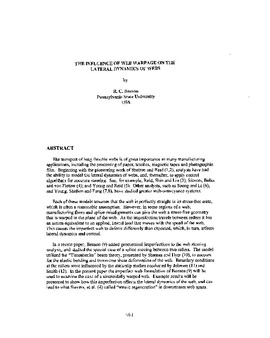| dc.contributor.author | Benson, R. C. | |
| dc.contributor.other | International Conference on Web Handling (1999) | |
| dc.date.accessioned | 2019-11-07T15:30:16Z | |
| dc.date.available | 2019-11-07T15:30:16Z | |
| dc.date.issued | 1999-06 | |
| dc.identifier | oksd_icwh_1999_benson | |
| dc.identifier.citation | Benson, R. C. (1999, June). The influence of web warpage on the lateral dynamics of webs. Paper presented at the Fifth International Conference on Web Handling (IWEB), Stillwater, OK. | |
| dc.identifier.uri | https://hdl.handle.net/11244/321769 | |
| dc.description.abstract | The transport of long flexible webs is of great importance in many manufacturing applications, including the processing of paper, textiles, magnetic tapes and photographic film. Beginning with the pioneering work of Shelton and Reid (1,2), analysts have had the ability to model the lateral dynamics of webs, and, thereafter, to apply control algorithms for accurate steering. See, for example, Reid, Shin and Lin (3); Sievers, Balas and von Flotow (4); and Young and Reid (5). Other analysts, such as Soong and Li (6); and Young, Shelton and Fang (7,8), have studied greater web-conveyance systems. | |
| dc.description.abstract | Each of these models assumes that the web is perfectly straight in its stress-free state, which is often a reasonable assumption. However, in some regions of a web, manufacturing flaws and splice misalignments can give the web a stress-free geometry that is warped in the plane of the web. As the imperfection travels between rollers it has an action equivalent to an applied, lateral load that moves with the speed of the web. This causes the imperfect web to deform differently than expected, which, in turn, affects lateral dynamics and control. | |
| dc.description.abstract | In a recent paper, Benson (9) added geometrical imperfections to the web steering analysis, and studied the special case of a splice moving between two rollers. The model utilized the "Timoshenko" beam theory, presented by Shames and Dym (10), to account for the elastic bending and transverse shear deformation of the web. Boundary conditions at the rollers were influenced by the stick/slip studies conducted by Johnson (11) and Smith (12). In the present paper the imperfect web formulation of Benson (9) will be used to examine the case of a sinusoidally warped web. Example results will be presented to show how this imperfection affects the lateral dynamics of the web, and can lead to what Sievers, et al. (4) called "weave regeneration" in downstream web spans. | |
| dc.format | application/pdf | |
| dc.language | en_US | |
| dc.publisher | Oklahoma State University | |
| dc.rights | In the Oklahoma State University Library's institutional repository this paper is made available through the open access principles and the terms of agreement/consent between the author(s) and the publisher. The permission policy on the use, reproduction or distribution of the article falls under fair use for educational, scholarship, and research purposes. Contact Digital Resources and Discovery Services at lib-dls@okstate.edu or 405-744-9161 for further information. | |
| dc.title | Influence of web warpage on the lateral dynamics of webs | |
| osu.filename | oksd_icwh_1999_benson.pdf | |
| dc.type.genre | Conference proceedings | |
| dc.type.material | Text | |
